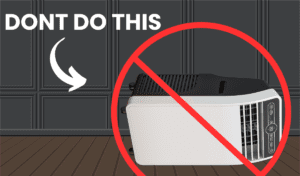Learning how to choose a portable air conditioner for your needs based on efficiency and effectiveness can be a daunting task. There are so many options in the market. With the increasing temperatures and humidity worldwide, portable air conditioners have become a popular choice.
Table of Contents
What is BTU?
A BTU, or British Thermal Unit, measures how much heat an air conditioner can remove from a room. Think of it as a number that shows how powerful the air conditioner is.
A higher BTU number means the air conditioner can cool a bigger space. If the BTU is too low, the room won’t get cool enough. If it’s too high, the air conditioner may cool the room too fast without making it comfortable.
Choosing the proper BTU rating
When buying a portable air conditioner, one of the most important considerations is its cooling capacity, measured in BTUs. While higher BTU ratings mean more cooling power, it also means more energy consumption. Therefore, choosing the proper BTU rating of a portable air conditioner that is appropriately sized for the room is crucial. A unit that is too small will struggle to cool the space. While a unit that is too large will consume more energy than needed.
Here is a general BTU chart for air conditioners based on room size:
| Room Size (square feet) | Recommended BTUs |
|---|---|
| 100 – 150 sq. ft. | 5,000 – 6,000 BTUs |
| 150 – 250 sq. ft. | 6,000 – 7,000 BTUs |
| 250 – 300 sq. ft. | 7,000 – 8,000 BTUs |
| 300 – 350 sq. ft. | 8,000 – 10,000 BTUs |
| 350 – 400 sq. ft. | 10,000 – 12,000 BTUs |
| 400 – 450 sq. ft. | 12,000 – 14,000 BTUs |
| 450 – 550 sq. ft. | 14,000 – 18,000 BTUs |
It’s important to note that this chart is a general guide, and other factors such as ceiling height, insulation, and climate can affect the required BTUs for a specific space. It’s always best to refer to the manufacturer’s recommendations to ensure that you select the appropriate BTUs for your air conditioner.
Understanding Energy Efficiency
Understanding Energy efficiency ratio (EER or SEER) is another critical factor to consider. This rating measures how efficiently the unit uses electricity, and a higher EER indicates a more efficient unit. Choosing an energy-efficient unit can help reduce energy bills, making it more economical in the long run.
Here is a chart showing the best energy efficient ratings (EER) for portable air conditioners:
| EER Rating | Efficiency |
|---|---|
| 9.0 – 9.9 | Good |
| 10.0 – 10.9 | Better |
| 11.0 or higher | Best |
It’s important to note that a higher EER rating means that the air conditioner is more energy efficient. This can result in lower electricity bills. However, air conditioners with higher EER ratings may also come with a higher price tag. It’s important to consider your budget and energy usage needs when selecting a portable air conditioner.
There are two types of Portable Air Conditioners
There are two main types of portable air conditioners: single-hose and dual-hose units. Single-hose units are more affordable and easier to install, but they are less efficient because they use the same hose to expel hot air and bring in fresh air from your cooled room. Dual-hose units use separate hoses for intake and exhaust, making them more efficient at cooling a space.
Don't forget to evaluate the noise level
When considering effectiveness, it is essential to evaluate the noise level of the portable air conditioner. Some units can be quite noisy, which can be disruptive to sleep or work. Choosing a unit with a noise level of 50 decibels or lower is recommended.
Here is a chart showing the best noise levels for quiet portable air conditioners:
| Noise Level (dB) | Description |
|---|---|
| <50 | Very quiet |
| 50-60 | Quiet |
| 60-70 | Somewhat noisy |
It’s important to note that the noise level of a portable air conditioner can vary based on the model and the fan speed setting. A quieter air conditioner can be more desirable, especially for bedrooms or areas where low noise levels are important. It’s recommended to choose a portable air conditioner with a noise level of 50 dB or lower for optimal quietness.
Conclusion
In conclusion, selecting the best type of portable air conditioner based on efficiency and effectiveness depends on specific needs. A properly sized unit with a high EER rating and a dual-hose system will generally provide the most efficient and effective cooling. However, other factors such as noise level and cost should also be considered. Evaluating these factors will help you find the best portable air conditioner to keep you comfortable during the hottest months of the year.
Aircon Rescue can work with any design of portable air conditioner you choose. Our Seamless Acrylic Panel Window connections will make sure you are optimizing your unit.
Frequently Asked Questions:
The size of the portable air conditioner you need depends on the size of the room you want to cool. Measure the square footage of your room and consult the manufacturer’s guidelines to determine the appropriate cooling capacity (measured in BTUs) for your space. As a general rule, larger rooms require higher BTU ratings for effective cooling.
When choosing a portable air conditioner, consider features such as adjustable fan speeds, programmable timers, remote control operation, and energy-saving modes. Additionally, look for units with easy-to-clean filters, quiet operation, and adjustable air direction for customizable comfort.
Look for portable air conditioners with high Energy Efficiency Ratio (EER) ratings, which indicate the unit’s energy efficiency. Energy Star certified models are also recommended for their energy-saving features and lower operating costs. Additionally, consider features like programmable timers and eco-friendly refrigerants to further enhance energy efficiency and reduce electricity consumption.








